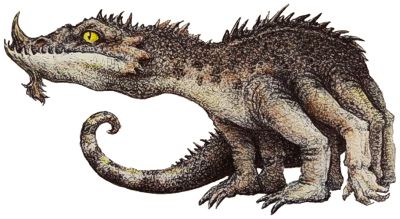

Monstrous Manual

| Lesser | Greater | Dracolisk | |
|---|---|---|---|
| Inférieur | Supérieur | Dracosilic | |
| Climate/Terrain: | Any land | Any land | Any land |
| Frequency: | Uncommon | Very rare | Very rare |
| Organization: | Solitary | Solitary | Solitary |
| Activity Cycle: | Day | Day | Day |
| Diet: | Carnivore | Carnivore | Carnivore |
| Intelligence: | Animal (1) | Low (5-7) | Low to Average (5-10) |
| Treasure: | F | H | C,I |
| Alignment: | Neutral | Neutral | Chaotic evil |
| No. Appearing: | 1-4 | 1-7 | 1-2 |
| Armor Class: | 4 | 2 | 3 |
| Movement: | 6 | 6 | 9, Fl 15 (E) |
| Hit Dice: | 6+1 | 10 | 7+3 |
| THAC0: | 15 | 11 | 13 |
| No. of Attacks: | 1 | 3 | 3 |
| Damage/Attack: | 1-10 | 1-6/1-6/2-16 | 1-6/1-6/3-12 |
| Special Attacks: | Gaze turns to stone | See below | See below |
| Special Defenses: | Nil | Surprised only on a 1 | Nil |
| Magic Resistance: | Nil | Nil | Nil |
| Size: | M (7’ long) | L (12’ long) | H (15-20’ long) |
| Morale: | Steady (12) | Champion (16) | Champion (15) |
| XP Value: | 1,400 | 7,000 | 3,000 |
These reptilian monsters all posses a gaze that enables them to turn any fleshy creature to stone; their gaze extends into the Astral and Ethereal planes.
Although it has eight legs, its sluggish metabolism allows only a slow movement rate. A basilisk is usually dull brown in color, with a yellowish underbelly. Its eyes glow pale green.
Combat: While it has strong, toothy jaws, the basilisk’s major weapon is its gaze. However, if its gaze is reflected, and it sees its own eyes, it will become petrified itself, but this requires light at least equal to bright torchlight and a good, smooth reflector. In the Astral plane its gaze kills; in the Ethereal plane it turns victims into ethereal stone. These will only be seen by those in the Ethereal plane or who can see ethereal objects.
The greater basilisk is a larger cousin of the more common reptilian horror, the ordinary basilisk. These monsters are typically used to guard treasure.
Combat: The monster attacks by raising its upper body, striking with sharp claws, and biting with its toothy maw. The claws carry a Type K poison (saving throws vs. poison are made with a +4 bonus). Its foul breath is also poisonous, and all creatures, coming within 5 feet of its mouth, even if just for a moment, must roll successful saving throws vs. poison (with a+2 bonus) or die (check each round of exposure).
Even if a polished reflector is used under good lighting conditions, the chance for a greater basilisk to see its own gaze and become petrified is only 10%, unless the reflector is within 10 feet of the creature. (While its gaze weapon is effective to 50 feet, the creature’s oddly-shaped eyes are nearsighted and it cannot see its own gaze unless it is within 10 feet.)
The sages say that the dracolisk is the offspring of a rogue black dragon and a basilisk of the largest size.
The result is a deep brown, dragon-like monster that moves with relative quickness on six legs. It can fly, but only for short periods – a turn or two at most.
Combat: This horror can attack with its taloned forelegs and deliver vicious bites. In addition, it can spit a stream of acid 5 feet wide and up to 30 feet away. The acid causes 4d6 points of damage, half-damage if a successful saving throw vs. breath weapon is rolled. The dracolisk can spit up to three times per day.
The eyes of a dracolisk can petrify any opponent within 20 feet if the monster’s gaze is met. Because its hooded eyes have nictating membranes, the monster is only 10% likely to be affected by its own gaze. Opponents in melee with a dracolisk and seeking to avoid its gaze fight with a -4 penalty to their to attack rolls.
